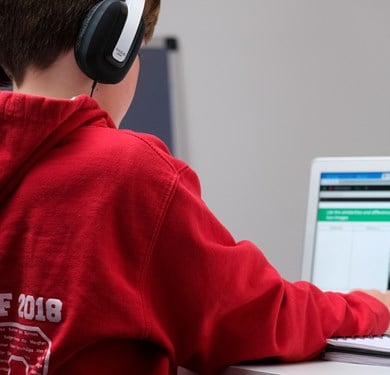13 September 2021
Reflecting on remote education
Neil Rickus is Leader of CAS Hatfield Primary Community, he’s also Senior Lecturer in Computing Education at the University of Hertfordshire and is the Computing tutor on the Primary PGCE course at Brunel University, London. Here, he examines how the experience of remote education is having a lasting impact in the classroom, and talks to teachers about their tips and experience:

Asynchronous digital remote education often highlighted the need for children to have access to appropriate resources to enable independent working. As learners increasingly have access to digital devices in school, the use of online resources can continue to feature in lessons, such as accessing self-study materials or activities to reinforce learning. Having pupils work remotely has also meant the collaboration features of online learning platforms are increasingly familiar and can enable individuals to work together on shared content.
Shared Google Slides have become a really important part of my lessons. As well as students producing shared presentations to demonstrate their learning, we also RAG (red, amber, green) our confidence related to each learning objective at the start and end of the lesson within a presentation.
Assessment
One of the assessment approaches often used when educating remotely is low-stakes quizzes, which enable children to quickly reflect on their learning and provide formative assessment data to teachers. Jay Parrack, Computing Teacher, Thomas Alleyne Academy, noted, “My classes love Kahoot and we have continued its use at the end of a lesson within school. The technology engages the children with evaluating their progress and the information from the quizzes helps inform my planning.” As quizzes can be accessed on a range of devices, there may also be an opportunity for learners to use their own technology within lessons where school devices aren’t available.
Assessment of computing presents a number of challenges, including the importance of not focusing solely on an activity’s outcome and the need to examine the development process being undertaken. Whilst being educated remotely, pupils often used digital technology to record a learning journey or created an e-portfolio showing their progress, which included both written and video content. Martin Sexton, Faculty Leader of Business, Health and Computing, Mildenhall College Academy, outlined how they are keen to continue this practice within school. “Having the students document their progress on Microsoft OneNote has been great, as it enables us to see their progress over time and how their understanding has developed throughout a sequence of lessons.”

Curriculum
Being away from school, or having limited opportunities for students to move around classrooms, has often meant unplugged activities haven’t been included as extensively in lessons as previous years. In addition to this, difficulties around sharing and cleaning devices has meant physical computing devices have often stayed in cupboards.
Matthew Wimpenny-Smith, Assistant Head Digital Strategy at Headington Prep School, outlined how he addressed these challenges. “We ensure the children continue good hygiene routines within lessons and provide regular cleaning of devices,” he said.
As outlined in the recent BCS article, BCS Responds to New Research Highlighting Digital Skills Gap, the lack of young people’s digital skills has been particularly evident as our reliance on technology has increased. Many schools are revisiting their computing planning to ensure there is a balance of all aspects of the National Curriculum, rather than focusing on the programming elements, utilising tools such as the National Centre for Computing Education’s (NCCE) Teach Computing Curriculum, which includes lesson plans, slides, worksheets, homework and assessment activities for key stages 1 to 4.
Opportunities for children to develop their digital skills across the curriculum are also being examined; particularly in primary schools, where Barefoot Computing resources have enabled schools to incorporate computing content within their existing topics.
Ben Davies, Computing Subject Lead, St Paul’s Primary School, Manchester, discussed how, “we've allocated additional time within the curriculum to ensure digital skills, such as saving a file into a folder, are reinforced and understood by children.”
Staff training and development
Many teachers, at the start of the pandemic, took the opportunity to undertake CPD activities delivered online. Through alleviating the need for attendees to travel, many providers saw an increase in participant numbers and received excellent feedback. Subsequently, a large amount of free (or bursary funded) CPD continues to be offered online, including some CAS Community of Practice meetings with teachers regularly using sessions to develop and share remote education experiences at community meetings. Resources have also been developed to enable community leaders to share the latest remote education research. The NCCE’s Teach Computing courses and Barefoot Workshops also continue to be available remotely.
Significant support is also still available for schools to develop their use of digital remote education technology, such as the digital platforms provided by Google and Microsoft. The EdTech Demonstrator Programme provides resources and guidance to support schools, including development of a digital strategy to help embed technology usage within your setting.

Wellbeing
Finally, whilst our classroom may be returning more to “normal”, it is important we continue to consider wellbeing throughout the school community. In particular, the increased prevalence of digital technology can make the boundaries between work and home become increasingly blurred, which can impact on our ability to take time away from school life. Hello World magazine’s issue 13 includes practical steps and advice on how to help manage your digital wellbeing (pg. 42-43).
Get in touch
What did you begin doing when educating remotely, which you now continued in the traditional classroom? Why not join the conversation on our CAS member forum, or via our social media channels on LinkedIn, Twitter, Facebook or Instagram.







